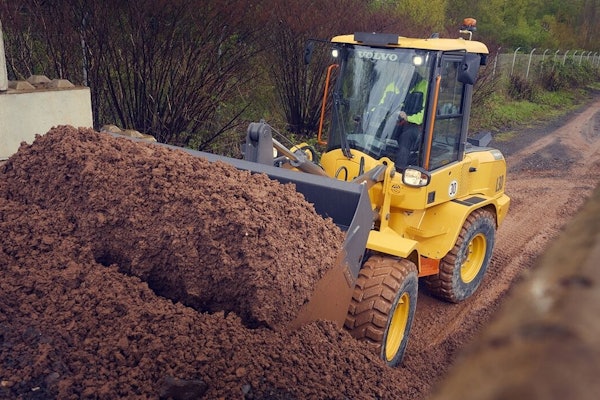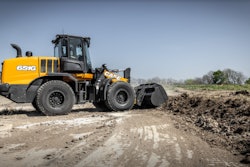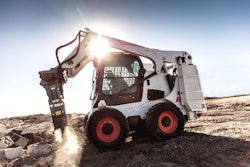A new app has been developed to eliminate the human error in checking grades off grade stakes.
Grade Stake Pro is designed to quickly solve the disconnect between the physical stakes on a jobsite and the GPS machine control system, says its creator Matthew Schwarz.
Schwarz comes on The Dirt to show how the app works and how contractors can save time and money by using it.
He notes that even when using GPS machine control there can still be costly errors. Operators fail to check and recalibrate their systems for blade wear. There can be signal interference that sets blade depth incorrectly. The tip of a rover can slip too deeply into the surface it's measuring.
He also notes that with many younger, less-experienced workers on the job, such errors can be more frequent.
To solve that problem, Grade Stake Pro takes your jobsite and grade stake information to calculate to a hundredth of an inch where you need to be at all times on the job.
So to find out more about this new tool to ensure accuracy on the jobsite, check out the latest episode of The Dirt.
Equipment World serves up weekly videos on the latest in construction equipment, work trucks and pickup trucks – everything contractors need to get their work done. Subscribe and visit us at equipmentworld.com!
In This Episode:
- 00:00 - Grade Stake Pro: An App to Help You Get Grade Right
- 00:30 - What was the Inspiration Behind Grade Stake Pro?
- 01:15 - What Does Grade Stake Pro Do?
- 02:05 - Grade Stake Pro Demo
- 06:17 - Why Should You Consider Grade Stake Pro?
- 11:20 - What is the Pricing Structure for Grade Stake Pro?
- 12:09 - Can You Use Grade Stake Pro with Your Phone?
- 12:34 - How Do You Learn More About Grade Stake Pro?
- 12:56 - Final Thoughts
Bryan Furnace (00:00):
Today we're here to talk about something pretty sweet. It is an application that was designed by one of you, someone in the industry that saw a problem that needed fixing, and so he went out and built an app to fix it. Today we're here to talk with Matt from Grade Stake Pro about his application and how it can potentially help you on your job site.
(00:30):
So from what I understand, Grade Stake is a tool that you've implemented to help translating grade stakes, that whole process, easier for boots on the ground. Is that correct?
Matthew Schwarz (00:42):
Yes. I came up with the Grade Stake Pro app after just trials and tribulations working in the field, younger guys on the job, trying to keep the dozer moving, and the human errors that we ran into. There's that disconnect from the physical grade stakes on the job site versus your GPS system. We run all GPS equipment, but you still need to manually check that to make sure your output is what your output's saying it is.
Bryan Furnace (01:06):
Yeah.
Matthew Schwarz (01:08):
The human error I ran into, the variance of different people doing it, I said there got to be a better way, and that's why I came up with this app.
Bryan Furnace (01:16):
So at just a high level, can you tell us what Grade Stake does and then we'll get into a demo of it?
Matthew Schwarz (01:23):
Well, the Grade Stake app basically takes all your job information, which is inputted in inches. We got the curb height, we got the concrete depth. If you have an asphalt overlay, rock, different levels of rock, and it also deals with your dirt levels. All that's in inches from the blueprints in your plans. It converts that into tenths so you can do your math when you come to the actual grade stake. So once you have your job information entered, then you go to the next screen, which takes you to your grade stake information and you just fill in the grade stake information, you hit calculate, and it'll take you to the last screen and it'll give you all your answers. It'll tell you where you need to be for top of rock, top of dirt, et cetera.
Bryan Furnace (02:04):
So that being said, can we run a couple of scenarios through the Grade Stake Pro app and just get a feel for how the process works?
Matthew Schwarz (02:12):
Absolutely. So here with the actual app, once you log in, it's going to take you to your job info. This is where all your job information is located. So you got two options. Now, depending on how your company would want to set it up, the administrator could be dealing with this and entering all this information. Or you can have a superintendent or a foreman or somebody in charge out in the field entering this at the job, but you have the option of adding a new job or you can go down to your pull-down menu and you can pick a job.
Bryan Furnace (02:44):
Really, if I'm understanding this screen correctly, what this is going to do is give us the concrete measurements of what our curb height's going to be on this job, what our concrete depth is going to be in stone grade?
Matthew Schwarz (02:56):
Yes.
Bryan Furnace (02:57):
Okay.
Matthew Schwarz (02:58):
So we're going to enter a new job here. Job notes is free text. You can put down station numbers or any other notes you need to keep track of. Curb height, for this one, we're going to do six inches. There's going to be no asphalt overlay. We'll do a concrete depth of eight inches, and then the rock depth, you can add multiple layers of rock if the job calls for it.
Bryan Furnace (03:20):
So if we had a sand grade and a stone grade, this is where we could modify that as well?
Matthew Schwarz (03:25):
Absolutely.
Bryan Furnace (03:27):
Perfect.
Matthew Schwarz (03:28):
So we're just going to do a modified sub-base out of the ABC Quarry. It's going to be nine inches, and then we're going to save our job information, job's created. Now, our job name is going to appear up here in the upper right-hand corner, project, The Dirt. That's kind of a sanity check. Every screen you go to, it's going to make sure it gives you the job information so you know you're on the right job. Now, you have four options once you get to the stake info. We all know reading grade stakes. Once the surveyor sets those, they pick an elevation. So it's either top of slab or finished grade here, bottom of slab or the bottom of the concrete, top of curb or your sub-grade. Those are the four we have.
(04:10):
So around the Midwest where I work, top of slab is encountered 90% of the time. Then you have your fill, or your cut, so whichever one you choose. And then you put in a number value, whatever it says on the grade stake. So in this scenario we have a fill of six-tenths, and you hit calculate. Goes to the next page. Again, job number's up here at the top. We have a sanity check for the stake information. We put in top of slab, we put in a fill and it was six-tenths. And here's our values where we need to be for top of rock, top of dirt.
Bryan Furnace (04:45):
So it's breaking each of those items down so I know exactly what my math is?
Matthew Schwarz (04:50):
Absolutely. This takes it down to the hundred. And you know as well as I do, people when they're out in the field, it's hot, it's sweaty, we're trying to move around, we've got equipment moving around us. People start rounding, and when you start dropping those hundreds off those numbers, you can start being a half-tenth or a tenth off after a while if you extrapolate that out.
Bryan Furnace (05:09):
Sure.
Matthew Schwarz (05:10):
This gives you solid information one time. So now the end user is in a circular path right now, so the only button they have to hit is back to stake info. They go to the next stake. Say the next state's a cut of 1.58. There's your answers.
Bryan Furnace (05:28):
Interesting. So very quickly I can just run down a whole row of stakes. I don't have to do any thinking. I just have to input the numbers on the stakes, and then it's going to export all of the information I need to actually fill in the information for my operator that's chasing me, or whatever I need to do with that information?
Matthew Schwarz (05:47):
Absolutely. What I've been doing it with is some of the younger guys, I'll give them two colored pens, and I'll have them put TR and TD with the number value on the stake below the information that's already on there. So we got top of rock and top of dirt. That way someone else comes out and wants to do a spot check, the information's already on there, they don't even have to go to the app again. But they can go to that stake, know those numbers are correct, because it was done in the app and the math is correct. We eliminate that human error as best as possible.
Bryan Furnace (06:17):
So Matt, one of my questions is, why should someone consider an application like Grade Stake Pro?
Matthew Schwarz (08:12):
Well, with the way the economy is right now and the way jobs are going, things are getting tight out there. The bottom line matters. Your margins are so razor thin right now. Here in the Midwest, we're experiencing companies buying jobs.
Bryan Furnace (08:25):
100%.
Matthew Schwarz (08:27):
I'm not sure how that is in other places, but right now people are buying jobs just to keep their guys working.
Bryan Furnace (08:31):
Yes.
Matthew Schwarz (08:31):
That doesn't give you much room. When you're in that kind of aggressive market, everything you can do to make yourself better has to be put out there. The cost of my app is so insignificant to the problems it solves, it's a no-brainer. Just the time it would save your employee going down and doing the grade stakes, say they got a hundred grade stakes on a job, the time they could save, they'll pay for it just within the hourly salary for the year. So it's low cost, but the return is huge.
(09:03):
You look at the different breakdowns of the process, and we have some with the GPS. Now, GPS is awesome. Everybody should be running GPS, but there are some limitations. You get some interference with clouds, trees, other bases close by. You have some equipment issues if you don't have your hydraulics set up correctly, your tolerance is set up there. You have blade wear. So we have some variables there. They're small, but they're there, and you need to acknowledge them. Then you have operator error, operator running the machine too fast, he's not paying attention to a blade or how the dirt's rolling out from underneath the blade, and you lose some grade there.
(09:39):
The other thing is with the app, it takes out the human error of conversion. So we get guys that move from job to job, they get to a certain stage and they'll get in their head, "Well, I was at this job yesterday, it was nine inches of concrete and 10 inches of rock." Well, today's job we're six inches of concrete and we're seven inches of rock. It's nothing they meant to do intentionally, but they screw up and they get the numbers mixed up in their heads.
(10:05):
You got the right job in here, it takes care of all that for you. It takes care of the conversion, it takes care of the math, it takes care of those slip of mind mistakes. Plus, it speeds it up and it gives that end user so much more confidence in what they're doing. Their performance rises when they use this app. So for example, just doing a simple two-lane road 33 foot wide, so you get some offset for the paver to get down, 300 foot long, so inside radius to radius and one city block. If you're off eight-hundreds or an inch of rock, that's 50 ton of rock. I don't know what the per ton price is at your area, but here it's about 24, 25 dollars.
Bryan Furnace (10:47):
It ain't cheap, yeah.
Matthew Schwarz (10:48):
You're talking 1,200 bucks just for the rock. That's not the truck.
Bryan Furnace (10:50):
Just for the rock.
Matthew Schwarz (10:50):
Just for the rock. You're not talking the trucking. You're not talking the additional use of the machine to put it down and roll it back in. You're not talking about any of that extra time. And God forbid you got the dirt elevation wrong and you didn't get enough rock, now you're stripping rock off. Now we got bigger problems.
Bryan Furnace (11:09):
Absolutely.
Matthew Schwarz (11:10):
Because the rework went from hours to days, plus you got contaminated rock the inspectors are not going to let you put back down, and things spiral out of control quickly.
Bryan Furnace (11:20):
Yeah. From here, I guess my question is, how does this work as far as a payment method? And we don't have to get into the actual pricing, but is the structure, is it a subscription-based model? Is this something that I'm purchasing an app? How does that work?
Matthew Schwarz (11:34):
It's a subscription. So a customer would have to buy an administrative license, which is one charge, and then there's a very minimal charge per user per month, which they can turn on and off as they need. So say you have a company of 50 people and 30 of them work street reconstruction or jobs that are heavy with a grade stake, you can turn on 20 of those at the beginning of the year. If some guys leave, you drop them off, you add some guys, however you need it, but you have the flexibility to add and subtract them throughout the year, month by month.
Bryan Furnace (12:08):
Gotcha. Then from the design here, it looks like this is already set up to work on a mobile phone, and I'm assuming that's what you've geared it towards, is someone pulling their phone out of their pocket?
Matthew Schwarz (12:19):
Correct. Yes, this is all geared towards using it on your phone. It's a mobile web-based app, so we're not in the app stores. It's a web-based app. It's been working very well for us. We've had this in place since August of last year.
Bryan Furnace (12:32):
Gotcha. So if someone wanted to look into getting Grade Stake Pro on their job site, where would they go to get more information and perhaps look into the pricing structure?
Matthew Schwarz (12:44):
Www.gradestakepro.com. They can request it demo or info, and we will be in touch with them right away.
Bryan Furnace (12:49):
Perfect. Well, Matt, thank you for the demonstration and we appreciate the tool you're offering to the industry.
Matthew Schwarz (12:55):
Well, thank you very much.
Bryan Furnace (12:56):
Well, thanks again for Matt coming on the show to talk about Grade Stake Pro. As you can see, this is a nifty little tool that can absolutely save you some serious money down the road just by preventing human error, which we are all prone to on our job sites. So as always, I hope this helps you in your business. We'll catch you on the next episode of The Dirt.










